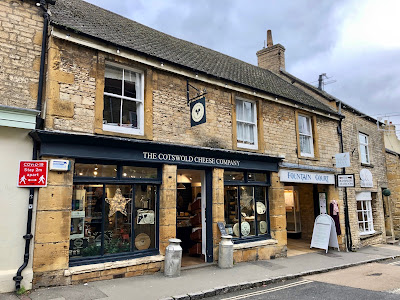Holiday Season Trip 8 - Stow-on-the-Wold
The second village was Stow-on-the-Wold. The village was also in honey color! It's the highest town in the Cotswolds standing 800 feet above sea level. I didn't feel we were at the top of the area, though.
Actually it's a market town, bigger than a village. That large ancient market square told its geological importance. It's not only located in the heart of the Cotswolds but also at the junction of six roads, including the Fosse Way, a major Roman road that was built in the first and second centuries and runs from Exeter in Devon in the south to Lincoln in the northeast. When the Cotswold wool industry was booming, it is said that about 20,000 sheep were sold at one time during its annual fairs. I wished to see the market square filled with cute fluffy sheep!
However, none of those facts were a real reason why I picked the town to visit. The answer was at a church behind the market square, St Edward's Church. It was originally a Norman church built in the 11 or 12th century, but has been added to and renovated over several centuries, which resulted in the current church's multi-style architecture. But my interest only focused on a certain door.
This one! The north door bound by two ancient yew trees! It's known as the model for the Doors of Durin, or the West gate to Moria in Lord of the Ring. It is said that J. R. R. Tolkien visited the church and the door inspired him. It's less than an hour drive there to Oxford, where he studied and later served as a professor of Anglo-Saxon as well as of English Language and Literature for more than 30 years. The connection between him and Stow-on-the-Wold would be possible. First of all, that door was totally something that fits to his story.
We had a lunch at Lucy's Tearoom. I was interested in the place because it has received many good reviews (4.5 by over 1,000 reviews on tripadvisor!) and the photos of scones, cakes and sandwiches looked very nice. However, when we entered the tea room, there were only some cakes displayed at the counter, which didn't look special. We got a table at the upstair dining room while I still wondered if it was a right place to be due to my trauma from the bun place in Bath.
Well, I didn't need to be concerned. My fish finger sandwich, which J also had, was pretty good. My Darjeeling tea that was made with loose leaves and served in a pot, tasted fine. I wished I had a large appetite at that time so that I could have ordered an afternoon tea!
We did some shopping in the town. The lovely three kinds of cheese for the Christmas Eve's lunch came from the Cotswold Cheese Company on Digbeth Street!
England's oldest inn was also in the town. Parts of the building, which is now a pub with rooms called the Porch House, were over 1,000 year old. It is said the place was once a hospice built by order of a duke called Aethelmar in 947, where pilgrims and merchants stopped off on their ways. It's another proof that Stow-on-the-Wold was on an important route!
To be continued...













